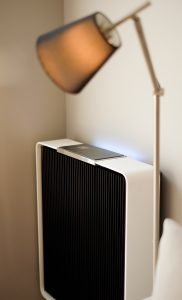One of the common ways of using electricity to provide room heat in a building is to use a panel or column heater that has a material like oil heated by an electric element.A variant that existed in the UK and, to some extent, Australia was a “storage heater” or “heat bank” that used a heavier material like bricks that stored more heat and was heated during overnight when the power was cheaper. Then this material diffuses this heat in to the room. These kind of heaters are able to provide this diffused heat to take the chill off a room but were expensive to run.
But Qarnot, a French cloud-computing firm, have looked at the issue of using the waste heat from a computer integrated in this heater to heat a room or building. Here, they have designed the Q.Rad which connects to your home network and electrical power and works as a data-server for their distributed-computing effort while using the waste heat to heat a room.
It also implements an integrated power meter so that you can be reimbursed for the power that it uses as part of the cloud-computing network, effectively providing “free heat”. But a question that can be raised for implementation in markets like Australia, New Zealand or, increasingly, the USA is the requirement to calculate transferred data and establish a mechanism to refund users’ bandwidth charges for this data. This is because of the practice where ISPs are either charging for data transferred or throttling users’ bandwidth if they transfer more than an allotted amount of data.
The data that Qarnot processes using these heaters is typically for the likes of research labs, banks and animation studios where they “offload” calculations in to this cloud-computing array. They also have the ability to seek out distributed-computing research projects of the SETI or Folding@Home kind to keep the network alive and generating heat where needed. For data security, these heaters don’t implement any storage for the distributed-computing client’s data while implementing end-to-end encryption for this data,
Qarnot will implement an “upgrade and replace” program so that higher-speed processors are used in the Q.Rad computing heaters and there is the ability to deal with failed equipment quickly and easily to assure high availability.
Householders are still able to adjust the heater to their preferred comfort level and make it reflect their lifestyle by using a smartphone app or the controls on the heater. This kind of thermostatic control is achieved by deflecting some of the workload away from the heater that is not needed when there isn’t the need for heat output.
They rate the output of a single unit to around 500 watts which would cover a 150-300 foot area in an insulated building. Qarnot are also pitching these heaters as part of the smart-building concept by having them able to be equipped with sensors and being programmable for any IoT / building-automation application. Similarly, Qarnot have added functionality like USB or Qi wireless charging to these heaters so users can charge mobile devices on them.
At the moment, these heaters are being issued to large buildings in Europe and the USA where 20 units or more need to be deployed. But in 2017, Qarnot wants to release these heaters to individuals who want to take advantage of this heating concept. For householders, this may be seen as being advantageous for “always-needed low-output” heating applications such as kitchens, downstairs areas in split-level houses and similar areas.
In some cases, Qarnot could make it feasible to have the Q.Rad heaters provide services to a network, whether as a router, NAS, home-automation hub or something similar. This could be achieved through the use of extra hardware or software to fulfil these tasks.
What Qarnot has done is to harvest waste heat from computing processes and use this for heating rooms in buildings with little cost to the building owner.



